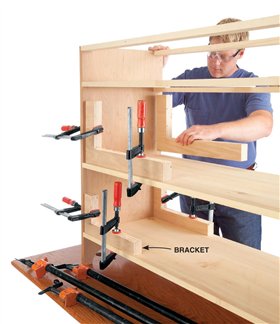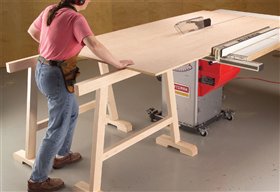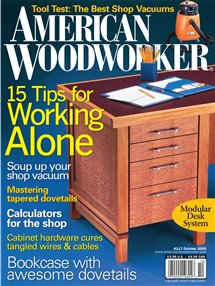We may receive a commission when you use our affiliate links. However, this does not impact our recommendations.

Working Alone
Solitary Strategies for Three-Handed Tasks
By Tim Johnson
One of woodworking’s major attractions is
being able to say, “I built that myself.” On
the surface, this statement is about mastering
skills and techniques. But on another level, it’s about
independence—the satisfaction that comes from discovering
methods that allow working successfully by oneself.
Woodworking is loaded with situations, large and
small, in which a little ingenuity can replace a call for
help. So put down the phone and read on!
Keep It Together with Brackets
Keeping large or complex assemblies square during glueup
can be a real headache. Heck, when you’re alone, just
assembling all the pieces can be a pain in the neck. You won’t
need aspirin or an assistant if you use 90-degree brackets.
They’ll hold things in position during assembly and keep
the assembly square when you glue
and clamp it together.
|
|
Click any image to view a larger version.

|
Support Unwieldy Clamps
Without help, it’s tough
to hold a long, heavy pipe
clamp level while you draw
it tight. By supporting one
end, a spring clamp eliminates the
need for help from extra hands.
|
|

|
Hit the Skids
Managing the space in your shop can
be a real chore during a kitchen cabinet
project. Nailing skids on the bottoms
makes cabinets easy to move and also
keeps their veneered plywood sides from
chipping out.
|
|

|
Glue Complex Assemblies In Stages
There’s no rule that says you have to glue together a
tabletop or a cabinet all in one shot. When you work
alone, it’s easier—and a lot smarter—to glue in stages, tackling
only as many joints as you can safely manage. (Here, for
example, the left side joints are being glued first.) Then you
won’t risk having the glue dry before you can assemble and
clamp the joints. To ensure everything stays square and
properly aligned when you use this method, always clamp
the entire assembly together, even though you’re only
gluing a portion of it.
|
|

|
Turn Your Back On Sheet Stock
I’ve tried all kinds of carriers
and lifting strategies to
move heavy sheet stock, like
MDF, but this method is my
all-time favorite. Stand the
sheet on edge, grab the sides,
lean forward and go. Ninety
pounds never felt lighter. Of
course, this method is incompatible
with low ceilings inside
and windy days outside, unless
you enjoy MDF sailing.
|
|

|
Store Lumber Vertically
When you’re alone, it’s a
real chore to unearth boards
from the bottom of a horizontal
stack. Boards stored
upright against brackets are
easy to see and sort. Just flip
through the boards and tip
out the ones you want. You
don’t have to lift anything.
|
|

|
Use a Brad Nailer
By simultaneously holding
brads and driving them,
this air-powered hammer
allows you to perform a twohanded
job with one hand.
That means you won’t need
a third hand to hold the
workpiece. A brad nailer is
great for securing mitered
corners, tacking drawer
fronts in position or fastening
delicate moldings. Face
frames secured with a couple
brads won’t slide out of place
when you apply clamps during
glue-up. The tiny nail
holes are easy to disguise. You
can buy a brad nailer and a
small compressor for as little
as $200.
|
|

|
Go Mobile
Nothing helps a solo woodworker move
materials and machinery like a good set of
wheels. Size matters: Buy casters that can
handle heavy loads, at a minimum, a 125-lb.
capacity per caster. Large wheels, at least 3 in.
in diameter, provide clearance on uneven
floors and are less likely to stall on cracks or
power cords. Rubber tires ride
more smoothly and quietly
than solid plastic wheels.
They’re also more skidresistant
when the casters
are locked.
Four swivel casters
provide the best maneuverability;
pairs of
swivel and fixed casters
make a cart easier
to steer. Ball bearings
and wheel locks are essential.
Swivel casters should
have dual-action locks, so
they won’t roll or swivel.
Source
Note: Product availability and prices are subject to change.
Highland Hardware, tools-forwoodworking.com, 800-241-6748, 3-in. locking
swivel caster with plate, 150-lb.
capacity, #084050; 3-in.
fixed caster with plate, 150-lb.
capacity, #184050.
|
|

|
Let Horses Carry the Load
Trying to rip sheet stock
single-handedly while standing
8 ft. behind the saw is no picnic. A pair of horses the
same height as your saw table carry the load and leave a
path so you can easily guide the sheet from start to finish.
Used beside the saw, saw-height horses provide the same
stabilizing support for crosscutting sheet stock.
|
|

|
Reduce Friction
Like helping hands, slippery surfaces
make heavy stock slide easily
and seem lighter. Reduce drag on
your steel machine tables by coating
them with paste wax or a drylubricant
spray. Use melamine, which
is MDF with resin-impregnated
paper faces, for support tables. In
addition to reducing muscle strain,
melamine brightens your shop, is
easy to keep clean and costs only
one-third more than plain MDF.
|
|

|
End Gluing Time Trials
Yellow wood glues typically have about five minutes of open
time—that’s how long you have to assemble the joint after
you’ve applied glue. Five minutes is sufficient for simple glueups,
but this short window puts a real squeeze on a solo woodworker
facing an assembly with numerous joints.
One way to beat the clock is to buy wood glue with a longer
open time, from a couple extra minutes to half an hour,
depending on the formulation. The only trade-off is longer
clamp time, because these slow-setting formulations take
longer to dry.
Another clock-beating method is to spread glue with a trim
roller. It’s amazingly fast and the roller leaves a nice even layer
of glue. Trim rollers, packaged in a small plastic tray, cost about
$4 in a home center’s paint department. The rollers are
reusable; just rinse them out. Short-nap rollers produce the
best results.
Sources
Note: Product availability and prices are subject to change.
• Rockler, rockler.com, 800-279-4441,
Titebond Extend wood glue with 7- to 8-minute open time, #24623.
• Garrett Wade, garrettwade.com, 800-221-2942, Slo-Set Glue
with 30-minute open time, #62J04.01.
|
|

|
Short of Hands? Use Feet
To hold a workpiece on its edge for mounting
hinges, gluing on edge banding and similar tasks,
simply clamp handscrews to the bottom.
|
|

|
Use Feathers, Not Fingers
Featherboards make it easy to process long pieces. Like
extra hands—only better, because they keep fingers out of
harm’s way—featherboards firmly hold long pieces in position
at the start and finish of a cut. Using them, you’ll get smooth
results from end to end.
|
|

|
Go Wireless
Activate your dust collector from anywhere in
your shop by installing a remote-control system.
You’ll save steps every time you turn it on or off.
Even in a one-person shop, saved steps mean less
wasted effort and greater productivity, so remote
controls are as beneficial as an extra pair of hands.
Basic systems with a transmitter and relay box cost
no more than a premium-quality filter bag. If you
don’t want to carry a transmitter, you can install
switch-equipped blast gates, so your dust collector
starts and stops whenever a gate is opened or closed.
Upper-end systems activate the dust collector and
appropriate blast gate when you turn on any wiredin
tool.
Source
Note: Product availability and prices are subject to change.
Penn State Industries, pennstateind.com, 800-377-7297, Long Ranger RF Remote: LR110-3 (110V),
transmitter and 1-1/2-hp relay/receiver; LR220-3 (220V), transmitter
and 3-hp relay/receiver.
|
|

|
Unhinge Hallow-Core Doors
Economical and light in weight, hollow-core
doors make great temporary work surfaces, because
they’re so easy to maneuver. Used with sawhorses and
a couple 2x4s for support, they can handle a surprising
amount of weight. Workshop doors don’t have to
be good-looking, so bargain-shop at salvage yards or
scratch-and-dent bins.
|
|

|
Product Recommendations
Here are some supplies and tools we find essential in our everyday work around the shop. We may receive a commission from sales referred by our links; however, we have carefully selected these products for their usefulness and quality.

























